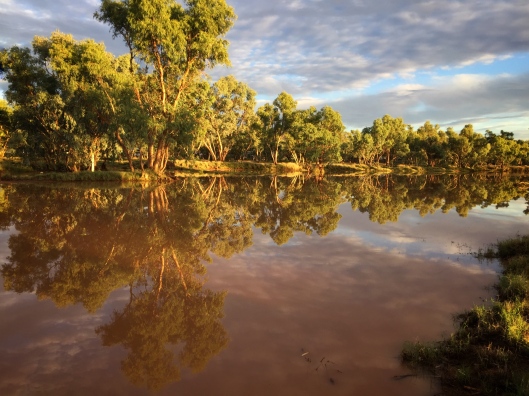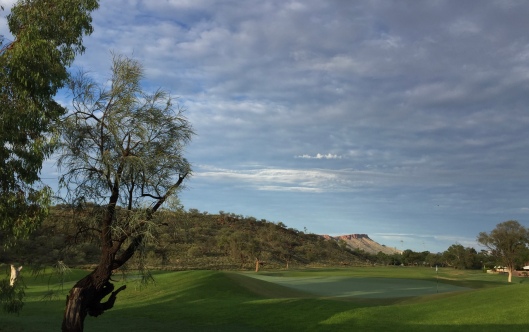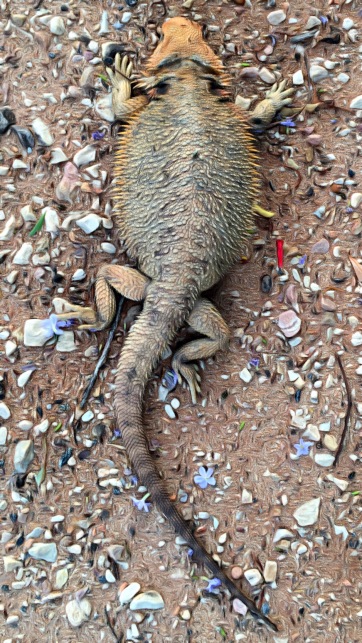
Normally dry Todd River in morning sunlight
Whenever I am asked what the climate is like in Alice, I answer that the temperatures range from -4 or -5C overnight in the winter to 40C+(104F) daytime highs in the summer. They usually respond with “Wow, that is hot” and it is the customary inside joke to reply “But it’s a dry heat”. At the moment, I really can’t say that without a huge caveat that we had 50% more rain than normal last year and it appears the pattern is continuing. The humidity and heat seep to my inner workings like rust into a motor, and nearly stop me. What doesn’t happen in the mornings before about 11am, seldom gets done until after a protracted siesta. (It is 6am and I am listening to rain as I write this)

can you see the green tinge on the ranges?

Don at work at the dining table with visitor and her joey looking in
Of course the local environment and our garden have responded to the wetter conditions, but not always in the ways we might have expected. The Ranges and outcrops are decidedly tinged with green, looking more like Ireland or Scotland than Central Australia. Wildlife is behaving somewhat differently, too. Usually when we have enough rain to boost the food sources in the scrub near town, the wallabies and kangaroos retreat from town to the bush and we don’t see them until things dry out again. This summer we’ve seen fairly regular appearances of them, one even stopping to have a look before breakfast earlier this week. My husband was working at the dining table and quietly called me to come have a look. I can usually tell by the quality of his voice if I need to grab my phone for a photo, and sure enough that was the case. A short while after this wallaby visited, a larger one, with joey under its own power, bounded up the steps and through the breezeway. They often use it as a ‘cut through’ to the scrub that is only one row of houses behind us. It was an entertaining way to start the day.

After the rain, droplets glisten like jewels
Curiously, a small family of dingoes has established itself nearby as well. It has happened previously, and is of some consternation to locals as the dingoes become fairly immune to urban life. Local domestic dogs have been taken and I have personally been stalked on my morning walks. The Rangers try to capture and relocate them when possible, but it can take a while. On a recent morning walk there were two dead and disemboweled wallabies near the path, and the following day another one. Very unsettling–and just possibly, the reason for the mums and their joeys to be moved in from out bush, if there has been a dingo population explosion–but I’m just speculating.

Bearded Dragon lizard (about 35cm/14″) long
Bearded dragon lizards have also made their presence known in larger than usual numbers this year. Found this poor fellow recently deceased along the walking path this morning. We have one in particular at our place that suns itself on the grassy knoll in front of the dining windows. (behind where the wallaby appeared) We watch with great interest how brave he is. One morning he seemed doomed, fending off five butcher birds that had him trapped. He prevailed, snapping back and outwitting them.
The native flora in the area has blossomed profusely, providing stunning photography subjects, as well as exceptionally stunning hay fever. Fortunately mine is mostly controlled with lubricating eyedrops and my husband has a nasal spray that he uses so that we can both sleep at night.
Because the cloud and rain kept the earlier summer months cooler than normal, many flowering plants came on later than usual. Our citrus trees have suffered the most, the lime having only about a dozen fruits and the lemon tree which is normally prolific, not a single fruit. Puzzling. Both trees are about 15 years old and, except for the first year, have never missed a year without more than enough fruit for us and the neighbours.
In the darkest hours, the Outer Kingdom is filled with a din of crickets punctuated by the clicking of burrowing frogs that have come to the surface for their short life cycle. Spiders have nearly taken over outside, spanning incredible distances that I can’t help but admire…from afar. Every morning on my walk I have to carry a stick to clear the webs in front of me. Walking into spider webs is very unpleasant. I’ve seen grown men react worse than me. Ants frantically try to find dryer ground in between bouts of rain. Last summer we had the giant grasshoppers, but this is the summer of the teeny tiny ones. Their hundreds are no less damaging, devouring the tasty green parts of fig leaves with incredible precision. I live in hope of one year having figs on this, my third attempt of growing fig trees in 25 years. There has also been an explosion of that most charming of insects, the lady bug. I have had a dozen or more inside the house, which I have gently transported to the Outer Kingdom again. In fact, just now, when taking a break from writing I walked to the kitchen, and there was another one ensconced on a piece of plastic wrap!
I can’t help but think if I lived in a big city and the weather was significantly different, I may have missed all the changes taking place. But here, it is in our faces, and mostly we like it that way…as long as it isn’t attached to a web.

Spencer’s Burrowing Frog posing for a portrait






What a blessing to live in the #RedCentre! You’ve highlighted Mother Natures working beautifully Ardysez – as always.
A beautiful upside to weather that’s proven a challenge to deal with at times.
ML
x
LikeLiked by 1 person
Thanks so much Lou. Everywhere in Australia seems to be having unusual weather this year. Am just coming to from my protracted siesta… xx
LikeLiked by 1 person
Meteorology being a serious interest of mine, since I realized you lived in the ‘Alice’ I have very much kept an eye on your weather also. This year so very hot and so much thunder!!! Not that the hottest ever January in my neck of the woods thrills as four of our next seven days will be over 40 C and the rest barely under and there is no AC 😦 !! Lovely photos of this year’s wildlife around your home so beautifully situated . . . tho’ am somewhat wary of the dingoes. Because of Pastor Chamberlain’s death a few days back the whole Azaria and dingo story naturally has resurfaced in the media . . . well remember all of us back then wondering over the truth . . .
LikeLike
Yes, I have been seeing that the temps east and south of here are unusually hot as well. We just have to get through it. I’m wary of dingos too, and yes, Pastor Chamberlain’s death this week was a reminder to be vigilant, I think. Thank you Eha.
LikeLike
Beautiful pictures, beautifully written, makes me all the more anxious for our coming visit…..well except for maybe the dingos, though I would like to see them from afar!
LikeLike
It is pouring rain again this morning, having rained off and on all night. Heard the dingos howling this morning in between rain showers. Goodness knows what things will be like when you arrive, maybe it will be a tropical environment by then! xx
LikeLike
Dingos not welcome. I hope they don’t bother you on your walk. It does seem like we have seen photos of a very wet Todd in recent seasons. All the rain makes for some beautiful photos, though. The mama and Joey coming by to say hi to Don is just too sweet. 💗
LikeLiked by 1 person
I was laying on the sofa early this morning, listening to the rain for a while. Then the rain stopped and the dingos began howling. It was quite a ruckus! I couldn’t believe they were in so close to the house. Thank you, Lorraine, for reading and commenting. xx
LikeLike
So pleased you’ve shared the rain induced reaction to the flora and fauna in your neck of the woods and then sharing with is. Thanks Ardys
LikeLike
My pleasure, Sandra. Pouring rain again at the moment. Thank you for reading. I hope you are getting some respite as well.
LikeLike
I’m almost glad you have weather changes Ardys. This was a great post and the photographs are wonderful. Aren’t some creatures just natural posers.
xxx Ginormous Hugs xxx
LikeLiked by 1 person
Thank you David. I do enjoy the weather changes, it makes for a very interesting life. Pouring rain again at the moment! xxx
LikeLiked by 1 person
What a wonderful science lesson here today… I love these images and narration of the region you live in. Ardys, I “feel” and see along your walks and live your observations as if I was right there with you. These candid images of everyday life are outstanding! Your dingos and our coyotes sound very similar. I am still seeing way too many coyotes in the orchard, to feel comfortable letting Emma and Ronnie free (we had hoped to turn them loose this coming week). I would really like to see Ronnie gain a little more size before freeing them both.
LikeLiked by 1 person
Yes, Lori, I think the dingos and coyotes fill much the same niche. I got a good science lesson, too, from your comment on Celi’s blog this morning about how insulated deer’s coats are. Thank you for reading and commenting Lori.
LikeLike
Alice’s rain finally arrived in my neighbourhood yesterday… such a welcome respite. The weather although it feels somewhat extreme is just summer I think. It gets me every year but I wouldn’t give it up for the world, although we are investigating air-conditioning arrangements appropriate to our now permanent living situation…
I love that your property is a comfortable habitat for wildlife. Us too, although we were unsure when an eyecatching Bandy Bandy snake turned up at our back door late at night a few days ago…I did a frantic how dangerous is it internet search while the G.O. in his undies just emerged from the shower on the wrong side of the door stood guard… Not very poisonous, and gentle was my findings, which was a relief as it slipped through a crack to beneath the house where we assume is where it came from. But like you, we enjoy our proximity to the Outer Kingdom… but would prefer it not to encroach on our Inner Kingdom.
LikeLike